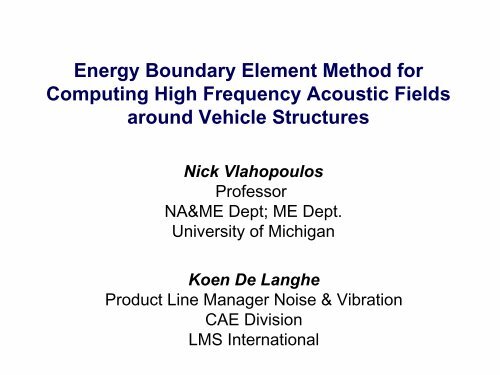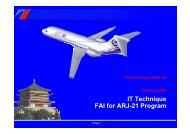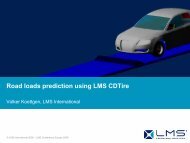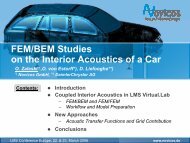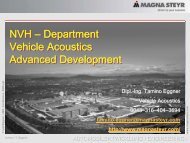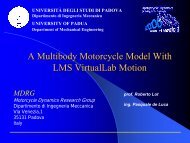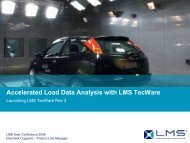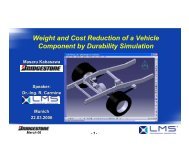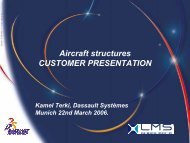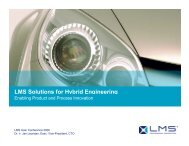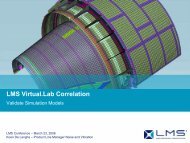Energy Boundary Element Method for Computing High Frequency ...
Energy Boundary Element Method for Computing High Frequency ...
Energy Boundary Element Method for Computing High Frequency ...
Create successful ePaper yourself
Turn your PDF publications into a flip-book with our unique Google optimized e-Paper software.
<strong>Energy</strong> <strong>Boundary</strong> <strong>Element</strong> <strong>Method</strong> <strong>for</strong><br />
<strong>Computing</strong> <strong>High</strong> <strong>Frequency</strong> Acoustic Fields<br />
around Vehicle Structures<br />
Nick Vlahopoulos<br />
Professor<br />
NA&ME Dept; ME Dept.<br />
University of Michigan<br />
Koen De Langhe<br />
Product Line Manager Noise & Vibration<br />
CAE Division<br />
LMS International
Presentation Outline<br />
•Development of EBEM<br />
•Technical background<br />
•Validation cases (automotive & aircraft)<br />
•Airborne noise analysis combining EBEM with EFEM<br />
•Integration with Virtual Lab<br />
•Conclusions
Development of EBEM<br />
Originally EBEM was developed <strong>for</strong> propagating acoustic<br />
energy in the field from EFEM acoustic intensity results<br />
EFEM model<br />
Structural model<br />
External/Internal fluid<br />
EFEM results:<br />
Structural vibration,<br />
Interior acoustic energy<br />
Radiated acoustic intensity<br />
Intensity<br />
EBEM results (external medium):<br />
Acoustic energy<br />
Acoustic intensity
EBEM and Airborne Noise Analysis<br />
External SPL is required <strong>for</strong> an airborne noise analysis<br />
Measurements are used <strong>for</strong> defining external acoustic field<br />
EBEM computes the external acoustic field – loading<br />
<strong>for</strong> airborne simulations
Technical Background<br />
Governing Integral Equations:<br />
e~<br />
Y<br />
2<br />
⎛ ρ k ρ<br />
∫ ( )<br />
⎟ ⎞<br />
= σ P<br />
⎜ + dS<br />
S 2 4 2 2<br />
⎝ 64π<br />
r 32π<br />
r ⎠<br />
2<br />
~ k ρc<br />
I Y<br />
= ∫ σ<br />
S<br />
( P)<br />
ErdS<br />
2 2<br />
32π<br />
r<br />
Numerical Implementation:<br />
n<br />
e ~ ⎡<br />
⎤<br />
Y<br />
= ∑ σ<br />
j<br />
⎢⎣<br />
∫ G(<br />
, Y ) dS<br />
S j<br />
⎥⎦<br />
j=<br />
1<br />
ξ IY<br />
= ∑ σ<br />
j∫<br />
~<br />
n<br />
j = 1<br />
⎡<br />
⎢⎣<br />
S<br />
j<br />
H(<br />
ξ,<br />
Y)<br />
dS<br />
⎤<br />
⎥⎦<br />
ρ<br />
G ( ξ Y)<br />
+<br />
2 4<br />
64π<br />
r<br />
, 2<br />
k<br />
2<br />
( ξ,<br />
Y) 32π<br />
r ( ξ,<br />
Y)<br />
2<br />
ρ<br />
= H ( ξ Y )<br />
2<br />
k ρc<br />
2<br />
32π<br />
r<br />
, =<br />
2<br />
E<br />
r<br />
( ξ,<br />
Y) [ K ]{} σ = { P}<br />
JSV 278 (2004) pp. 413 - 436
Compared to traditional BEM…<br />
Conventional BEM<br />
~550,000 elements up to<br />
8,000Hz<br />
Treatment of irregular<br />
frequencies<br />
EBEM<br />
~2,200 elements with no upper<br />
frequency limit<br />
No irregular frequencies<br />
No phase in<strong>for</strong>mation
Compared to SEA…<br />
SEA uses artificial reverberant<br />
acoustic subsystems <strong>for</strong><br />
modeling an unbound external<br />
acoustic field<br />
Coupling loss factors between<br />
external acoustic subsystems<br />
EBEM is mesh based
Validation Case Studies<br />
Windshield<br />
Roof AB<br />
Roof BC<br />
Glass AB<br />
Glass BC<br />
Door AB<br />
Door BC<br />
Source 1<br />
Source 2<br />
Source 5<br />
Source 3<br />
Source 4<br />
Truck: ~4,600 elements; 6min <strong>for</strong> the entire frequency range<br />
Sedan: ~2,100 elements; 1.5 min <strong>for</strong> the entire frequency range<br />
Aircraft: ~1,900 elements; 1 min <strong>for</strong> all frequencies
Windshield<br />
Roof<br />
Automotive Validation<br />
Glass<br />
Door<br />
Source 1<br />
Source 2<br />
Source 5<br />
Source 3<br />
Source 4<br />
Locations of sources<br />
and measurement locations<br />
Floor
Windshield<br />
Roof<br />
Glass<br />
Door<br />
Source 1<br />
Source 2<br />
Source 5<br />
Source 3<br />
Source 4
Windshield<br />
Roof<br />
Glass<br />
Door<br />
Source 1<br />
Source 2<br />
Source 5<br />
Source 3<br />
Source 4
Experimental Set – Up from NASA/TM-2001-210840<br />
Airframe model, microphones, and source<br />
Impinging jet source
Validation<br />
~300 ft<br />
Insertion loss calculations<br />
Acoustic pressure on field point<br />
mesh in free field and in the<br />
presence of the aircraft;<br />
The difference between the two<br />
is the IL
Test<br />
EBEM<br />
200Hz<br />
1,600Hz
EBEM – EFEM Case Study: Internal noise prediction in NASA<br />
test-bed cylinder due to an external acoustic source
EFEM validation <strong>for</strong> NASA Aluminum Test-Bed Cylinder
Magnitude of difference between test and analysis averaged over all frequencies<br />
Third octave bands from 315Hz to 6,300Hz<br />
∑ dB(<br />
e)<br />
test<br />
− dB(<br />
e)<br />
N<br />
N<br />
EFEA
EBEM computes the external acoustic loading<br />
on the cylinder – provides the excitation <strong>for</strong> EFEM<br />
Acoustic energy density loading on the source side
EFEM - models the structure and the interior acoustic<br />
space<br />
Source side<br />
Side opposite to the source<br />
Distribution of vibrational energy density on the shell<br />
of the cylinder
EFEM - models the structure and the interior acoustic<br />
space<br />
Source side<br />
Internal acoustic SPL<br />
Side opposite to<br />
the source<br />
Results in the interior of the cylinder – solid elements<br />
are used to model the air
EBEM toolbox<br />
Integration with VL
There are three buttons in the toolbox;<br />
pre-processing, analysis, post-processing<br />
Pre-processing panel;<br />
Tabs <strong>for</strong> each required step
Summary<br />
•EBEM is a high frequency acoustic prediction tool<br />
•Efficient computation of the acoustic loading from<br />
air-borne sources<br />
•Mesh based – utilization of conventional pre and<br />
post-processors and integration with VL<br />
•Complements conventional BEM at high frequencies<br />
•Provides the acoustic loading <strong>for</strong> airborne SEA and<br />
EFEM computations


